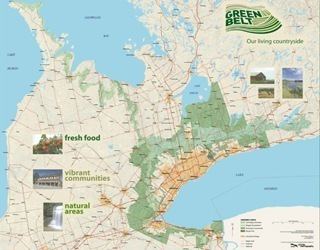Area 7,200 km² | Established 2005 | |
 | ||
Similar Rouge National Urban Park, Holland Marsh, Mount Nemo Conserva, Heber Down Conserva, Lake Simcoe | ||
The Greenbelt is a permanently protected area of green space, farmland, forests, wetlands, and watersheds, located in Southern Ontario, Canada. It surrounds a significant portion of Canada's most populated and fastest-growing area—the Golden Horseshoe.
Contents
- History
- Purpose and composition
- Protected Countryside
- Niagara Escarpment
- Oak Ridges Moraine
- Current conservation recognition and future
- Future
- References
Created by legislation passed by the Government of Ontario in 2005, the Greenbelt is considered a major step in the prevention of urban development and sprawl on environmentally sensitive land in the province. At over 1.8 million acres (7300 km²), the Greenbelt is one of the largest and most successful greenbelts in the world.
History
The Greenbelt is established around the Golden Horseshoe, which is one of the fastest growing urban areas in North America. The population in the region increased from 6.5 to 7.7 million between 1991 and 2001. The population increase put urban development pressure on areas surrounding the Greater Toronto and Hamilton. Between 1996 and 2001, the amount of farmland decreased by 7% in the GTA, and by 6% in Hamilton. The Golden Horseshoe's population is projected to increase to 11.5 million by 2031.
The idea of establishing a greenbelt in Ontario was created by newly elected Premier of Ontario Dalton McGuinty in his Speech from the Throne in November 2003. Bill 27, the Greenbelt Protection Act, 2004 became law on June 24, 2004. The new legislation, in conjunction with a zoning order issued by the Minister of Municipal Affairs and Housing, created a study area and placed a moratorium on some land uses until a specific plan was established. Bill 135, the Greenbelt Act, 2005 was introduced to the Legislative Assembly of Ontario for first reading of the bill in October 2004, and became law on February 28, 2005. It now provides permanent protection for the Greenbelt area.
Purpose and composition
The Greenbelt provides regulatory protection from urban development pressure due to this population growth. While protecting prime agricultural land is its primary purpose, it is actually a bundle of other key elements to also protect rural area, heritage sites, and sensitive ecological and hydrological features, which include the Niagara Escarpment and the Oak Ridges Moraine.
Protected Countryside
Agriculture protection is the primary element of the Greenbelt legislation. It prevents municipalities from re-zoning areas identified as "prime agricultural areas", "specialty crop areas" and "rural areas" identified by the province for other uses. These three areas compile the Protected Countryside (PC) element. The PC includes areas like the Holland Marsh which produces over $50 million of carrots, onions and other popular vegetables in very fertile soil. Other fruits and vegetables, dairy, beef, pork, poultry, and wine grapes are produced throughout the region.
Niagara Escarpment
The Niagara Escarpment is a geological formation that is the most prominent of scenic landforms in Ontario, reaching 725 kilometres long and up to 500 metres tall. It began as coastline of the Michigan Basin 450 million years ago. It was designated as one of 15 UNESCO World Biosphere Reserve in Canada in 1990. It is managed jointly by Ministry of Natural Resources and the Niagara Escarpment Commission. The area is protected due to the many unique species and prime recreation grounds. Tourism associated with the escarpment contributes $100 million to local and regional economies.
Oak Ridges Moraine
The Oak Ridges Moraine covers a 1,900 square kilometres (734 sq mi) between Caledon and Rice Lake, near Peterborough. It is a hydrological system of streams, wetlands, kettle lakes and ponds and their catchment areas, seepage areas, springs, and aquifers and other recharge areas.
Current conservation, recognition and future
The Friends of the Greenbelt Foundation is a not-for-profit organization that was created in 2005 to help foster the Greenbelt in Southern Ontario. The Foundation, which was provided $25 million from the provincial government, has funded many organizations and charities in the Greenbelt, which support agricultural and viticultural activities and restoring the natural environment.
The Foundation is also responsible for providing a "Friend of the Greenbelt" award that serves to "recognize and celebrate those individuals who make a significant contribution to Ontario's Greenbelt." In 2006, singer Sarah Harmer was selected by the Foundation for her "I love the Escarpment" tour, which aims to protect the Niagara Escarpment. In 2007, former Premier William Grenville Davis was presented with the award for adopting the 1973 Niagara Escarpment Planning and Development Act, which created the Niagara Escarpment Plan.
A report titled Ontario’s Greenbelt in an International Context was released in 2010 by the Canadian Institute for Environmental Law and Policy. The report concluded the Ontario greenbelt is the strongest for its supporting legislation versus nine similar greenbelts internationally.
A report titled GTHA Rural Property Inequities was released in 2015 in the Township of Scugog. This report concluded the Ontario greenbelt has many issues to overcome before it is a viable and sustainable proposition. It also concludes many of the supporters of the greenbelt are from metropolitan areas and don't contribute monetarily to its welfare.
Future
In 2015, the Greenbelt Plan started its 10-year review in coordination with the Growth Plan for the Greater Golden Horseshoe, the Niagara Escarpment Plan, and the Oak Ridges Moraine Conservation Plan. As part of the review, the Province is gathering public feedback through a series of community meetings and online. The Province has released a discussion document to "help inform and guide discussions."
